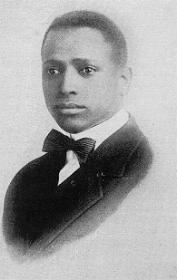

Dr. Lofton was married on January 9, 1916, to Miss Myrtle Louise Ellison, daughter of Castello and Lula Ellison. She was educated at Philander Smith College and pursued a course in Missions at Gammon. She teaches music. Of the four children born to them three are living. They are Verna W., Ely Leon, Jr., and Frances Helen Lofton.
Young Lofton pursued his elementary studies in the Lee County, Ark., public schools, from which he passed to Philander Smith College at Little Rock where he won his A.B. degree in 1916. This was followed by the theological course at Gammon Theological Seminary, where he won his B.D. degree in 1920. The story of these years cannot be told better than in his own words. He says, "I was with my father on a farm at Moro, Ark., till I was 17 years of age. I helped him pay for two farms, both about 140 acres. He was not able to school me. I got permission to stop going to public school and work on a railroad that was being built through that section. Many mornings I went to work half frozen to earn my first school money. I drove a road scrape and wheeler. I helped my father make the next spring crops and went back on the road in the summer. I helped to gather the crops and in November, 1908, I went to Philander Smith College, Little Rock, Ark. I had only $15.00. $3.50 was left after paying tuition and buying books. Col. G.A.A. Dean employed me as a servant. He gave me $1.00 per week and board and allowed me to go to schools. I was told his wife was the crank of cranks, and I thought so at first. After cleaning and dusting she would follow me with a white handkerchief. I did not suit her at all at first, being a country boy and nobody was ever known to stay more than a month or two at a time. We learned one another and before school was out understood one another. I remained in the home off and on for eight years, till I finished school. She gave me $3.00 per week and board after the first year. During vacations, I taught in the rural schools or worked in Southern Pacific Shops. Here I was first put on the scrap iron pile, and then transferred to machine shop and made a helper. I won three scholarships at Philander Smith College and was delegate to Student Conference at Atlanta in 1914; two years Bible Class President of Wesley M. E. Church; two years President of the Y. M. C. A. of the school. In order to get to Atlanta I borrowed $20.00 from the Mercantile Trust Company, without anyone going on my note. When I got to Atlanta I had $15.00. That was the fall of 1917. I had a wife and one child. Dr. Bowen, now Vice-President of Gammon Seminary, at first told me to get a job and go to work, that they could not let me enter on such a small sum as $15.00. After talking over the matter he agreed to give me a trial. After paying my rent for a month and buying my books I had 75 cents left. I went to town and assisted drummers two evenings, worked at a Greek restaurant one week for $5.00, then got a job on bell stand at Piedmont Hotel at salary of $20.00 per month and tips. I went to work at 11 P.M., off at 7 A.M., and met all other obligations. Another child was added to the family. I went to a brass foundry and worked a month and a half, brought on a strike and got a raise for all labor of 50 cents a day. I worked at American Steel plant one week. Burning out in this job I went to Cleveland, Ohio, working at American Wire and Steel Company, came back to school in fall. I then took a route carrying a paper, the "Atlanta Constitution," increased its circulation on the route from 45 to 300 subscribers. The next summer I was an insurance agent, building my own debit." In this way he was able to complete the course at Gammon. While at Gammon he was elected delegate to the Students Conference at Des Moines, Iowa.
Dr. Lofton's religious experience began with his conversion when he was thirteen years of age. At a very early age he felt drawn toward the ministry, and was finally led into the ministry by the conviction that it is better save folks than to rescue them--that salvation is greater than salvage. He was licensed in 1916 and joined the Conference in 1920, and was ordained elder in 1922. His first charge was the New Market Circuit in the Annapolis, Md. District, which he served for one year and paid the debt. This work was composed of five churches and a mission, so it will be seen that the young preacher was at least busy. His next appointment was to Churchton, Md., where he had two churches. In 1922 he was sent to Clarksville, W. Va., where the work is making steady progress under his administration.
Both as a laborer and as a preacher Dr. Lofton has studied conditions, and he says "A programme of education will mean the salvation of our people. Another great need is that the wealth which he earns or creates should be turned to his advantage. As laborers our people are furthest down in the struggle and are discriminated against by the labor unions. They have their greatest liberty in the mines. What the Negro needs most of all is that he be recognized as a man and given a man's chance. If the political, educational and industrial machinery were adjusted to that idea, the White man would rejoice as well as the Negro and the angels of heaven would join in the chorus."